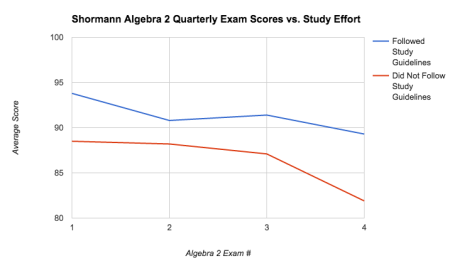Building Good Study Habits with Shormann Math

We just completed the beta-test of Shormann Algebra 2, our second course in the Shormann Math series. We learned a lot about what does and doesn’t work last year in the Shormann Algebra 1 course, so in building Shormann Algebra 2, we applied the good and cast the bad into the lake of fire.
A key part of Shormann Math is TruePractice™, the result of our efforts to design the most efficient system for building fluency in mathematics. If you want to be good at something, whether it’s baseball, piano, math, etc., there is simply no substitute for the need to practice. A lot. If, however, you think you can be good at something by receiving magical superhero powers while sitting on your couch, then you either watch way too many movies, or you’re weird. Or both! But there are more and less efficient systems for practice, and we are finding that our TruePractice™ system that includes 100 lessons with 20 problems per lesson is achieving good results, compared to John Saxon-authored math courses which average 120 lessons and 30 problems per lesson.
With Shormann Math, students build fluency through 1) Practice Sets that are designed with the understanding that “practice time” is different than “game time,” 2) Weekly Quizzes that are like a “practice game,” and 3) Quarterly Exams that equate with “game day,” “piano recital,” etc.
Regarding Quarterly Exams, take a look at the graph of average student score vs. study effort. On the week of a quarterly exam, we provide detailed instructions on what we believe are the best methods for studying for an exam. The key, as you probably know, is to practice a lot. Because our eLearning campus provides data on some, but not all aspects of student study effort, we can group students into those who followed our study guidelines (blue line) and those who did not (red line).
The results are not surprising at all and show that we have a good system in place for helping students build fluency in math. Follow the system and make an A. Don’t follow the system and make a B or worse. Our study guidelines are based on years of teaching experience, combined with years more of learning from good college math, science and engineering professors at top universities.
Are you a parent who wants a good and God-glorifying math curriculum for your child? Or, even better, are you a student who wants to know God better by using math as a tool for studying His creation, and you’ve been looking for a curriculum that will help you do this? If yes, take a look at Shormann Math today.
Explore posts in the same categories: Teaching Mathematics
Tags: Practice, Shormann Algebra 1, Shormann Algebra 2, Shormann Math, TruePractice
Both comments and pings are currently closed.